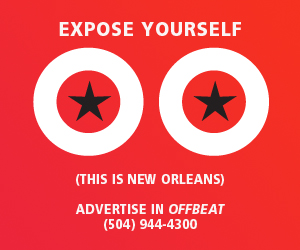This afternoon, Facebook and Twitter have been alive with reports of the city shutting down the Art House at 1614 Esplanade Ave. and attempting to evict its residents. The spectacle of the Art House’s Facebook page is an awkward one as everybody’s up in arms and saying what should and shouldn’t happen despite a an almost complete lack of legal knowledge (judging by the posts). Gambit‘s Alejandro de los Rios must have slept through the Nagin years when he wrote, “Chalk this up as one of the absolute worst decisions made by a city government in, well, ever.”
One person that I assume is a resident writes, “The city of NOLA just took a big bite out of its own culture”. On it’s face, that’s a lot of hype unless they’re hiding spy boys or clarinet players in the tree, but it’s not way far off. Given the importance of freaks and heads to the popularizing of New Orleans’ street music culture, counterculture enterprises are a valuable, overlooked part of the city’s history.
You’d think this is a case of The Man busting the poor, innocent little guy judging by the Facebook page. “This place was just beautiful,” one person wrote (verbatim, errors preserved). “This is the house of the rising sun, its more than just a venue for parties, its a historical and cultural landmark. we cannot let hm to do this to the house and the wonderful people who live there.” But the Treme neighborhood association told its members to call NOPD “to report an infraction, i.e. loud music, open fights, excessive trash thrown on street and/or neutral ground, damage to proporty of residents or vehicles in neighborhood.” Funny how really cool parties aren’t always really cool for the neighbors and one man’s treasure’s another’s nuisance.
All the overheated drama of youth aside, if the residents are being run out today without a chance to find new living quarters, that’s morally if not legally wrong (I know I’m not a lawyer and won’t speculate). Unfortunately, the story emphasizes the degree to which city government protects itself first, property values second, everything else third. The same dynamic that was at play in regards to the Mid-City Bonfire is manifested here. An underground phenomenon that existed outside of conventional capitalist forces bubbled up into the city’s consciousness (in this case, due to the Gambit cover story) and forced the city to deal with it. Like the bonfire, the issues connected to the house are real in one sense but overrated in others. At the bonfire, for instance, the chances of someone getting hurt were real, but in over a decade of going to the bonfire, I never saw anyone hurt. Similarly, drinking in a tree 50 feet off the ground sounds risky, but if partygoers weren’t surviving that, the parties would have ended or changed.
New Orleans (and to be fair, most cities, I suspect) doesn’t handle things that don’t fit neatly in a priority system that doesn’t put property values and money at the top. An arts collective certainly fits that bill, particularly one with social and aesthetic underpinnings borne out of rave and DJ culture. When in doubt, it will always side with homeowners against art expressions that aren’t easily commodified and the non-conformists who make them. And if the residents and partygoers are honest, they’d admit that the outside-the-law dimension was part of the buzz.
Really, the biggest mystery connected to the Art House raid is the seeming surprise that everyone has that they were raided. A proposed three-day festival for this weekend was nixed by the city, so the Art House tried to replace it with a one-night benefit-which would still amount to a smaller version of the thing the city already said no to. Like the Mid-City Bonfire, everyone who went to the Art House and visited it had to know that the days of such an unconventional space are numbered. Really, the success of the Art House is that it ever happened at all. That’s cold comfort when you’re facing eviction, but anybody who thought they’d grow old there was delusional.




